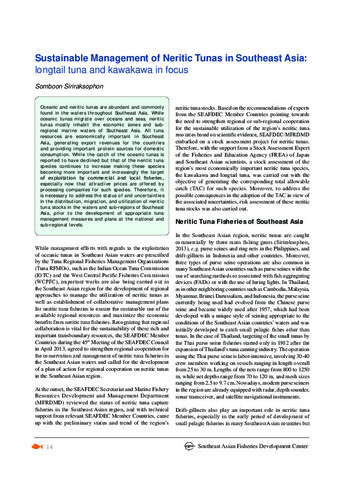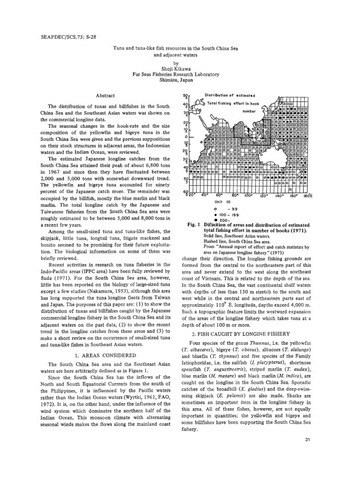Integrated Assessment of Neritic Tuna Resources in Southeast Asia: stock status, population genetics, age estimation, and reproductive patterns
Share
Abstract
The high demand for tuna and tuna-like species, both domestically and internationally, drives economic activity from catch to market, processing, and export. However, escalated fishing pressure on these species can lead to overfishing and depletion, threatening ecosystems and the economic stability of fishing communities, thus calling for sustainable fishing practices. To enhance the effectiveness of sustainable fisheries management policies, an integrated assessment that considers multiple aspects of these species is more accurate as it provides comprehensive information on their current status and helps guide evidence-based management strategies.
From 2020 to 2024, SEAFDEC conducted stock and risk assessments on two neritic tuna species (Euthynnus affinis and Thunnus tonggol) and two tuna-like species (Scomberomorus guttatus and S. commerson), along with genetic stock structure, age determination studies, and reproductive pattern of E. affinis. These studies offer critical insights into stock status, population dynamics, growth rates, and reproductive patterns. These activities align with the provisions of the ASEAN-SEAFDEC Resolution and Plan of Action on Sustainable Fisheries for Food Security for the ASEAN Region Towards 2030 (RES&POA-2030), particularly Resolution No. 12 “Strengthen knowledge, including local knowledge, and science-based development and management of fisheries by enhancing the national capacity to collect, analyze, and share fisheries data and information”; as well as POA No. 4 “Establish reference points, and come up with estimated biomass or capacity level to determine the maximum sustainable yield, allowable biological catch, or allowable effort for marine and inland fisheries”; and No. 27 “Foster cooperation with other countries for the conduct of stock assessment on straddling, transboundary, highly migratory, and shared fishery resources, as appropriate, to serve as inputs for formulating science-based fishery management plan; and strengthen subregional and bilateral cooperation including inter-agency cooperation for management of such resources.” The outputs will support the formulation of science-based fishery management plans and strengthen sub-regional and bilateral cooperation, including inter-agency cooperation, for the management of such resources.
Keywords
neritic tuna tuna-like species integrated assessment population genetics otolith reproductive patternsSuggested Citation
Saleh, M. F. M., Arshaad, W. M., Billy, A. N., Azmi, M. S., Jaafar, K., & Mohamad, S. N. (2024). Integrated Assessment of Neritic Tuna Resources in Southeast Asia: stock status, population genetics, age estimation, and reproductive patterns. Fish for the People , 22(3), 26-34. http://hdl.handle.net/20.500.12066/7575
Subject
Collections
Related items
Showing items related by title, author, creator and subject.
-
Scientific Report on Stock Assessments of Yellowfin Tuna (Thunnus albacares), Bigeye Tuna (Thunnus obesus) and Skipjack Tuna (Katsuwonus pelamis) in Sulu and Sulawesi Seas by ASPIC
Southeast Asian Fisheries Development Center, Training Department (Training Department, Southeast Asian Fisheries Development Center, 2017-11)Results of stock assessments should be looked at with caution because of following reasons, i.e., (a) Stock assessments (YFT: yellowfin, BET: bigeye and SKJ: skipjack tuna) in the SSS water, may not be meaningful because ... -
Sustainable management of neritic tunas in Southeast Asia: Longtail tuna and kawakawa in focus
Siriraksophon, Somboon (Secretariat, Southeast Asian Fisheries Development Center, 2017)Oceanic and neritic tunas are abundant and commonly found in the waters throughout Southeast Asia. While oceanic tunas migrate over oceans and seas, neritic tunas mostly inhabit the economic zones and subregional marine ... -
Tuna and tuna-like fish resources in the South China Sea and adjacent waters
Kikawa, Shoji (Japan International Cooperation Agency, 1977)The distribution of tunas and billfishes in the South China Sea and the Southeast Asian waters was shown on the commercial longline data. The seasonal changes in the hook-rate and the size composition of the yellowfin and ...




